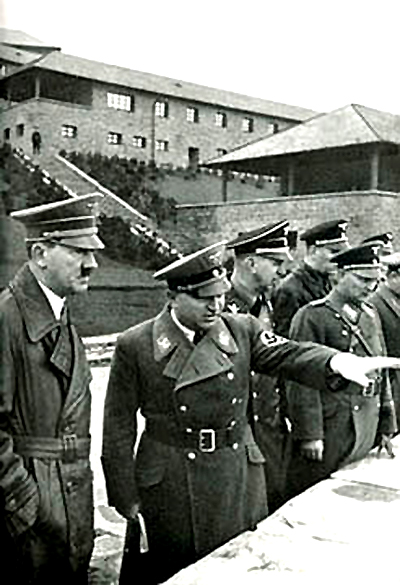![]()
![]() (English version)
(English version)

The minister for labour and organization, Dr. Robert Ley, and Adolf Hitle look around the Order Castle" Vogelsang" (1936)
(Archive: H.-D. Arntz)
A book written by the German author Hans-Dieter Arntz deals with the special tracking to elite Nazi ranks and racial institutions for future high-level personnel during the time of National Socialism in Nazi-Germany. The technical term “Ordensburg” translates into English as “Order Castle”.
Until 1986 there was a gap of knowledge on this special kind of adjustment and not a single book had been written on the ideology and especially on this kind of selection and training of the future “leaders” in Nazi-Germany. It was the German sociologist and upper secondary school teacher Hans –Dieter Arntz, who researched this unknown field of history. His research book “Ordensburg Vogelsang 1934-1945 - Erziehung zur politischen Führung im Dritten Reich” was published 1986 and had its 5th edition in August 2006. For twenty years it has been the only standard work in Germany which answers the political question: How to learn leadership in the “Third Reich”.
Since 1934 the term “Ordensburg” had been applied to an idea of an exaggerated national philosophy. It was no “school” for elite Nazi military ranks, but more a place for the political adjustment to National Socialism in Germany. The future “leaders” of the “Third Reich” (called “Junker”) were destinated for a political career in the NSDAP or administration of conquerred countries “all over the world”. They wanted to be regarded as “political readers” but who were in reality German fanatics and racists.
The term “Ordensburg” reminds one not only of a castle or a medieval fortress and knights of a German order fighting against the Prussian tribes, but also of a secret society of men. There were only three of them: Krössinsee, Sonthofen and the most important one: Ordensburg Vogelsang near Cologne. However, they were by no means “breeding places” of a Germanic gentleman race and also not a notorious address for “Lebensborn” (“Born and Fountain of Germanic life”), as even today many Germans want to know it.
Actually, they were newly-built NS-castles for future high-level staff of the NSDAP, which was the only political party during the time of German dictatorship. The selection of the “leader-candidates” (so-called “Junker”) aged between 23 and 27 and the drill and special training however were conducted in such a manner so elitist and aligned to the administration of German dictatorship that this fact still remains mystical. These candidates had to change such an Order Castle every year. Everybody should have attended Krössinsee, Sonthofen and of course the Order Castle “Vogelsang”.
They were not to be regular soldiers belonging to a conventional army, but they had to learn with a blind faith how to administer and govern. Under the command of the minister for labour and organization, Dr. Robert Ley, only three (!) “Ordensburgen” developed in the “Third Reich”.
In Krössinsee the candidates were aligned in character. At Sonthofen (Bavaria) they were supposed to be trained in political and diplomatic administration and in the tasks of military, but that Order Castle was never used like that. The most important of the three “Ordensburgen” was VOGELSANG, which was situated in the midlands of the Eifel near Belgium. It spread the racistic philosophy of the German dictatorship and the new order.
The book “Ordensburg Vogelsang 1934-1945” written by Hans-Dieter Arntz is a documentation which presents for the first time methodology and didactics of the order castles. It is a scientific, but nevertheless a very well readable contribution to the total topic: “Education for political leadership and command in the German dictatorship”. It consists of 260 pages with more than 250 photos and documents. To this day it is the only standard work on this political term.
As the “Ordensburg Vogelsang” trained future “leaders of the German National Socialism” for only three years (1936-1939), one can only imagine the potential effect “of the hardest school in the world”. It can be stated, however, that the impact of the “Führeranwärter” or “Ordensjunker” at the three castles of Krössinsee, Sonthofen and Vogelsang could have been an important contribution in order to carry out the plans of German rule in Europe in the long run.